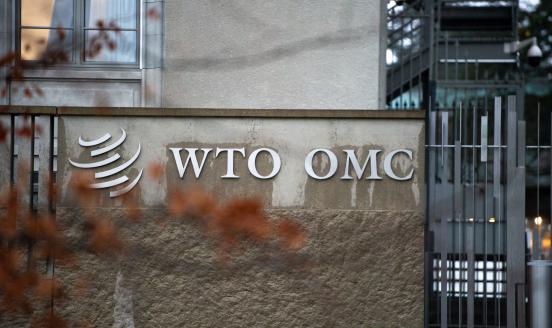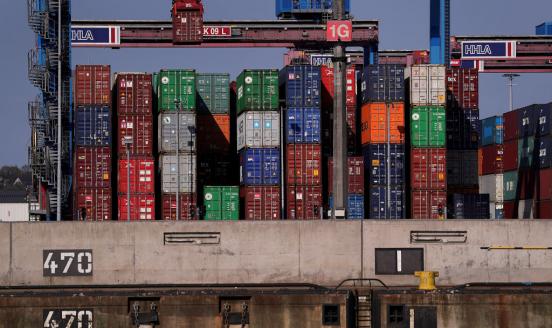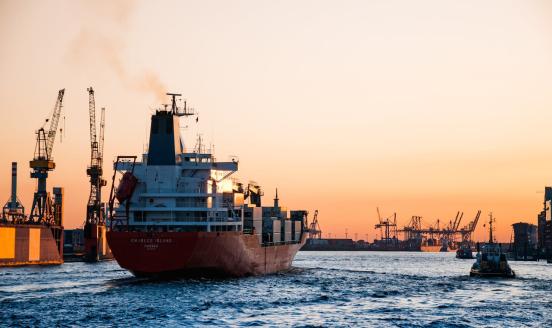NAFTA in play: How President Trump could reshape trade in North America
How will the story of NAFTA unfold under the Trump presidency? Uri Dadush examines three possible scenarios and provides an overview of the policy imp
This blog post was originally published by the Inter American Dialogue (IAD).

The author would like to thank Peter Hakim and Beatriz Leycegui for helpful comments on a previous draft.
During his run for President of the United States, Mr. Trump called the North American Free Trade Agreement (NAFTA), “the worst trade deal ever approved by this country”. His target is Mexico, which runs a $ 50 billion surplus of trade in goods and services with the United States. Trade with Canada, the third NAFTA party, is essentially balanced. However, NAFTA’s provisions cannot be changed without affecting Canada and without Canada’s consent, and the Foreign Ministers of Canada and Mexico have declared that they want the new NAFTA to be negotiated trilaterally, not bilaterally as Mr. Trump prefers.
Irrespective of procedure, negotiations between the United States and Mexico will cover issues that go beyond those of a typical trade agreement.
The President of Mexico, Mr. Pena Nieto, has issued a set of principles and objectives for the renegotiation of NAFTA, including that the negotiations must be comprehensive and enhance, not inhibit, the integration of North America.
Among likely topics to be discussed are migration, remittances, the treatment of Mexicans residing in the United States, security, illegal traffic, and modalities for building a wall along the 2000-mile border, and who will pay for it.
Even if NAFTA remains a narrowly defined trade agreement between Canada, Mexico and the United states, the possibility of side agreements and of making trade-offs across the broader set of issues on which the countries must collaborate will influence the outcome of the trade negotiations.
Matt Gold has argued that although, as some legal scholars have pointed out, the President has the authority to dissolve NAFTA on a few months’ notice, the agreement would remain in effect until Congress agrees to change its implementation statute. See report on Matt Gold’s Intervention at WITA
There are many possible scenarios that describe how the new chapter of the NAFTA story will unfold. To start with, legal scholars are divided as to how much Mr. Trump can do to dismantle NAFTA without ratification in Congress. As Mr. Trump has threatened to do, the United States could impose a large tariff on Mexico unilaterally. However, that would violate not only the rules of NAFTA but also those of the World Trade Organization (WTO), of which both Mexico and the United States are members.
A scenario where the United States withdraws unilaterally not only from NAFTA but also from the WTO would have severe consequences for the United States’ global economic and security interests. Although Mr. Trump has at times been dismissive of the WTO (as he has at different times been dismissive of NATO, the EU, the United Nations, the American media, the American courts, and the American Intelligence services), the Republican dominated US Congress has already signaled in various contexts that it will not support this option.
For example, when Mr. Pena Nieto, President of Mexico, cancelled a state visit following a provocative tweet by Mr. Trump, and the U.S. President’s press spokesman intimated that a large increase in tariffs against Mexican imports was being considered to pay for the border wall, there was an uproar in Congress and the statement had to be walked back. It is also possible that Mr. Trump, confronted with strong opposition in Congress and from business interests and the legal complexities of undoing NAFTA, will demur, or be content with cosmetic changes. But the record so far argues against underestimating his resolve. Also possible is a scenario where the Trump administration commits enough errors that the President’s political capital is irreversibly eroded. We will not consider any of these extreme scenarios further, even though they cannot be excluded.
Instead, we will focus on three more plausible scenarios for a new NAFTA, which is sometimes referred to as NAFTA 2.0. The first scenario, which I call NAFTA 0.9, describes an agreement which includes some novel enhancements, but also entails important new restrictions to address Mr. Trump’s concerns. On net, under NAFTA 0.9, the parties end up with somewhat less open trade.
The second scenario, which is more likely, I call NAFTA 0. This describes a breakdown of negotiations and a return to trade at arms-length under WTO rules between Mexico and the United States, while a separate deal is sooner or later negotiated with Canada.
The third scenario, which I call NAFTA/BAT is one where NAFTA remains little changed but the US Congress enacts a Border Adjustment Tax (BAT) whose effect – if the BAT takes the form currently assumed – is the same as a tariff and export subsidy applied to all trade of the United States, not just to trade with the NAFTA parties. The NAFTA/BAT scenario is the worst of all three in terms of its welfare effects on the NAFTA parties and on the rest of the world. However, at the time of writing (mid-February 2017), the outlook for BAT – in whatever form – is clouded in uncertainty.
In the rest of this note, we analyze the consequences of NAFTA 0.9, NAFTA 0, and NAFTA/BAT in turn. We conclude with a section on how other countries should react.
NAFTA 0.9
Trade in goods and services within NAFTA is largely free. Exceptions include a small number of goods, such as imports of dairy into Canada, and two important service sectors, namely telecoms and transportation. One possibility to broaden and deepen the existing agreement would be to tackle these remaining sectors while also building on the text of the Trans Pacific Partnership, which Mr. Trump recently jettisoned. Several sections of the TPP text envisage disciplines that go beyond NAFTA and are in a direction consistent with the interests of the United States.
Beatriz Leycegui and I examined these NAFTA + provisions of TPP in an article published by the Wilson center and in the Spanish edition of Foreign Affairs. The NAFTA+ aspects of TPP include broader, deeper, and more enforceable provisions on Intellectual Property, ECommerce, State Owned Enterprises, Investor State Dispute Settlement, and Labor and Environmental standards.
The new US Trade team may insist on strengthening some of these provisions further, for example by pushing for a better enforced and higher minimum wage in Mexico. In addition, there is an extensive North-American deeper integration agenda that TPP only touches on but which could be part of a new NAFTA agreement. This would include infrastructure and process improvements at the Border (“The 21st century border”), and regulatory cooperation (mutual recognition of standards). As a recent study by the Council on Foreign Relations recommended there is also much to do to step up energy collaboration across the North-American continent.
Negotiators may decide to place these agendas on the table, and all three parties may be interested in pursuing them. However, US negotiators will also be compelled to address the agenda implicit in Mr. Trump’s election manifesto: to reduce the trade deficit with Mexico, to impede foreign investment in Mexico for export to the US, to encourage job reshoring to the United States, and to raise revenue that can help pay for a wall along the Mexico-United States Border. The large devaluation of the Mexican Peso over the last year (itself in part a result of anxiety about the future of NAFTA) will make that agenda even more pressing.
Mexico has already rejected paying for the border wall, and Mexican negotiators are unlikely to concede much ground without getting something in return, and nor would Mexico’s domestic politics allow it. American, Mexican and Canadian negotiators could – instead - agree to make rules of origin more restrictive to prevent import of parts from Asia and Europe, raising barriers against third parties while providing increased export opportunities to each other. They could also agree to lower the threshold for safeguards against import surges.
Although Mexico has ruled out increases in tariffs, it may be convinced to allow the US to raise its tariffs from zero to 2-3%, the maximum allowed under US WTO MFN applied tariff obligations, while Mexico does the same. Canada would also have to agree to a new tariff schedule, and new complications would arise to identify origin in the Americas.
Even a small increase in tariffs would strip NAFTA of much of its meaning and would have to overcome strong opposition from lobbies in Congress. Such an outcome would not make much of a dent in the United States’ bilateral trade deficit with Mexico anyway. The deficit is more likely to widen than to narrow, given the lower Peso and the fiscal stimulus envisaged in Mr. Trump’s program. The difference in objectives among the parties is so large that negotiations may break down altogether.
NAFTA 0
Under this scenario, Mexico and the United States revert to trading with each other on an MFN basis. This would deal a very severe blow to the Mexican economy, but the adverse effects on segments of the United States economy would also be weighty. Even though the United States buys far more from Mexico than Mexico buys from the United States, the relationship is not as one-sided as Mr. Trump and some on his team appear to believe.
Mexico depends on the United States for 80% of its exports and $ for 25 billion of migrant remittances but the United States depends on Mexico, too. The United States’ exports to Mexico amounted to $ 267 billion in 2015, making Mexico its second largest export market after Canada.
Moreover, some 40% of US imports from Mexico consist of parts and raw materials produced in the United States and processed in Mexico. So a tariff on Mexico is a tariff on US producers as well. These aggregates are impressive but they understate the political and economic consequences of NAFTA’s end because they are very unequally distributed across firms, localities and families in the United States.
Among the most affected would be the integrated automotive companies, with production chains spanning across North America, Europe and Asia, corn, soybean and pork farmers which export to Mexico, and States such as Texas, which boasts the largest exports of any US State, 37% of which are destined to Mexico. The U.S. Department of Commerce estimates that 1.1 million American jobs depend directly on US exports to Mexico. Various other estimates suggest that 4-5 times as many jobs depend indirectly on exports to Mexico.
Two-way trade flows tell only a part of the story of the deep interdependence of the two nations: the revenues of affiliates of US service companies in Mexico, such as Wal Mart for example, exceed 40 billion $ a year. The revenues of US manufacturers which produce goods in Mexico and sell in Mexico are not reported in the trade statistics but are also big.
US FDI in Mexico exceeds $100 billion. Beyond the narrow economics, the relationship with Mexico is among the most important for national security. If US Mexico collaboration along the border were to cease, the risk of terrorist infiltration would increase, and policing drug trafficking, money laundering, illegal immigration from Mexico and Central America, and the smuggling of goods and weapons would become harder.
Under the MFN obligation, the United States and Mexico must apply the same tariff to each other as they apply to other WTO members unless they are party to a Free Trade Agreement. See WTO Tariff Profiles, 2016, for data on applied tariffs.
Suppose NAFTA negotiations did break down and NAFTA was dissolved. Then the US would have to raise Tariffs on Mexico to its WTO MFN applied level, which is 3% on average. In contrast, Mexico would be legally obligated to raise its tariff to 8% on average, and to 20% on agriculture, to remain WTO compliant. These tariff changes would be sufficient to disrupt production chains across the continent and to inflict substantial harm to farming interests, causing a political backlash against the new administration. And, given the limited room available for the United States to raise tariffs, the effect on Mexican exports would be small. So, even under this dark scenario it is far from clear that tangible progress would be made in reducing the bilateral trade deficit with Mexico.
It is worth noting that – based on the MFN tariffs and current trade patterns - the new tariff revenue accruing to Mexico from levying tariffs against the United States would be about $10 billion $ larger than the tariffs that Mexican exporters would pay to US Customs. American exporters would also suffer large preference erosion on Mexican markets, since, excluding NAFTA, Mexico has FTAs with 43 countries, including the countries that form the European Union and Japan, which are the United States’ most direct competitors across a wide range of sectors.
The collapse of NAFTA may also encourage Mexico to pursue or deepen FTAs with others, such as TPP signatories Australia and Thailand, or with Argentina and Brazil (Mercosur), placing US farmers at severe disadvantage. Meanwhile, US firms impeded from investing and buying in Mexico will not necessarily buy in the US, but instead replace imports from Mexico with those from low-wage Asia and from other countries in Latin America. Unless, that is, the United States makes all imports more expensive by imposing a Border Adjustment Tax.
NAFTA/BAT
The BAT is part of a much broader tax reform plan espoused by House Republicans and which entails lowering the corporate income tax from 35% to 20% and changing the way corporate income tax is calculated (See Freund, 2017, for a summary of a conference on the BAT recently held at the Peterson Institute). Under the BAT proposal, the cost of imported inputs will no longer be deducted from a company’s revenue to calculate income tax, while, at the same time, the revenue accrued from exports will no longer be included in a company’s total revenue.
So, Importers will pay much more income tax. A US based automobile producer that imports parts from Mexico or Canada would have to raise the price of its cars and source more of his components in Alabama instead. US Exporters would also pay much less income tax. A corn farmer in Kansas could lower prices on world markets and displace a Mexican farmer in Oaxaca, while a dairy producer in Wisconsin could displace one in Quebec.
Under BAT, this scenario would unfold regardless of the shape a new NAFTA might take. NAFTA could stay exactly as it is, and the BAT revenue associated with Mexican exports to the United States (about $ 50 billion a year based on current trade patterns and taking the form of increased corporate income taxes on US companies that import from Mexico) would more than cover the cost of subsidizing US exporters selling in the Mexican market (in the form of a $40 billion a year corporate income tax break), while allowing $ 10 billion a year left over for other purposes, including to defray the cost of building a border wall.
It appears inevitable that the BAT – if it takes the shape described above- will be challenged and found to be in violation of the WTO, since it represents, to all purposes, both a 20% tariff and a 20% export subsidy. The BAT would hurt all the United States’ trading partners, and so the value of US exports that could be covered by potential WTO sanction is an order of magnitude larger than anything the appellate body has imposed before.
The proponents of BAT see it as leveling the playing field with countries that have adopted VAT, some 160 countries including Canada and Mexico, and which apply VAT to imports but exempt exports. But this view is mistaken and reflects a failure to understand how VAT works. The VAT is a tax on consumption and its effect on consumer behavior and on producers is neutral with respect to both exports and imports. Consumers pay the same VAT whether they consume domestic or imported goods.
Producers do not bear the burden of the VAT (they act merely as tax collectors) and so are indifferent on whether they sell at home or abroad. The economic effect of the VAT is the same as that of Sales Taxes as applied in the United States. It is true that a consumer in Mexico or in Nova Scotia (Canadian provinces apply different VAT rates) will pay more VAT than an American consumer will pay sales tax, but that is entirely a choice for the United States to make. Sales taxes could be raised or a VAT could be introduced while remaining entirely WTO consistent.
The proponents of BAT also argue that it is not discriminatory against foreign producers because the dollar will appreciate to exactly offset it. While I believe some US dollar appreciation is likely to occur sooner or later if the BAT is enacted, no one can predict when and how much. This is true of all currencies that are free-floating, but is even more evident in the case of the US dollar, the world’s reserve currency. The value of the US dollar over any defined time interval is determined by asset preferences (holdings of physical assets, securities and cash) far more than by trade flows.
Factors such as growth prospects, expectations with respect to monetary policy, political risk, and expectations about the future trends in global energy markets will all play a role in setting next year’s US Dollar exchange rate. Since 2015, the US dollar has appreciated sharply against the Peso and the Canadian $ even though there have been no material changes in trade and tax policies. Conversely, whether BAT is enacted or not, many scenarios are imaginable where the dollar depreciates again aggravating the distortion.
There are numerous other criticisms the can be levied against the BAT idea which relate to its effect on the United States’ high income inequality (consumers will bear the burden), its reliability as a source of revenue (it depends on the size of the US trade deficit), and its systemic effects (it would imperil the WTO’s capacity to discipline tariffs and subsidies). But what most concerns us here is the likelihood that it will pass the political hurdles that stand in its way in the United States.
Although the BAT has run into strong opposition by importers such as retailers and oil refiners, the political momentum behind it is strong. Large exporters are only one part of the constituency in favor of BAT. Not only does the BAT appeal to the new administration’s protectionist sentiment, the border tax is also needed to fund the large infrastructure program that Mr. Trump has promised. A broad cross-section of businesses and individuals support the corporate and income tax cuts that the tax reform package envisages, and of which BAT is only one part.
The BAT will have the largest adverse effect on Canada and Mexico, but it will also affect all other United States’ trading partners. It will introduce economic distortions and an anti-trade bias which is worse for the United States, Canada and Mexico than the NAFTA 0.9 and even NAFTA 0 scenarios.
Policy implications for trading partners of the United States
The EU has already announced that they are preparing a challenge to the BAT in the WTO. Canada and Mexico should make clear from the outset that they will challenge the BAT, if enacted, under NAFTA rules as well as join the EU in its WTO challenge. If the United States persists with BAT regardless, all the United States’ large trading partners should not wait for the WTO to resolve the dispute, which could take many years. Instead, they should enact countervailing duties to the United States’ export subsidies, which the United States may then challenge in the WTO.
At the same time, Canada and Mexico should apply their best efforts to negotiate a NAFTA 0.9 agreement, which may provide Mr. Trump with political cover to backtrack from his protectionist intentions. If negotiations fail, Canada and Mexico’s interests may diverge, and while Canada can negotiate a bilateral free trade agreement with the United States that only slightly modifies NAFTA, Mexico will find it much harder to make a deal. In that case, Mexico should be prepared to revert to trading with the United States at arms-length with the United States, implying that the United States will confront Mexico’s much higher MFN tariffs.
The NAFTA outcomes have important and complex bearing on the trade interests of numerous third parties. Most important but least quantifiable is the impetus given to protectionist interests around the world by the example of the United States, the world’s largest economy and the architect of the Bretton Woods System. As already mentioned all countries will be affected by the enactment of BAT. By contrast, the immediate effect on third parties will be least in the NAFTA 0.9 scenario.
More restrictive rules of origin will hurt Asian and European suppliers of parts to producers across North-America which export in the NAFTA space. An agreement to raise tariffs to the United States’ applied MFN level, will mitigate the restrictive effect of rules of origin on third parties and will also reduce the margin of preference enjoyed by NAFTA producers. But it will hurt European and Japanese factories based in the NAFTA space.
Under nearly any scenario, it is quite likely that Canada and the United States will continue to operate under a NAFTA-like bilateral trade agreement. In the event of a NAFTA 0 scenario, however, third-party investors with factories in Mexico, as well as those with factories in the United States that buy and sell components to affiliates in Mexico will be badly hurt. However, so long as the United States remains within its WTO-agreed MFN applied and bound tariffs, there will be little legal basis to challenge US policies.
Under any scenario, it is important that Canada and Mexico step up their already considerable efforts to consolidate their ties with the world’s other trading blocks, beginning with the European Union with which Mexico has a trade agreement and Canada has concluded one pending ratification. Ties should also be strengthened with China, Japan, India, Brazil, Indonesia, Russia and Argentina to name some of the largest trading nations that compete with the United States and are complementary to Canada and Mexico.
The objective should not only be to strengthen bilateral ties, and provide a backstop to a possible retreat of the United States, but also to establish a coalition to support the WTO and the expanding network of free trade agreements that constitute one of the world’s most valuable public goods, the multilateral trading system.



